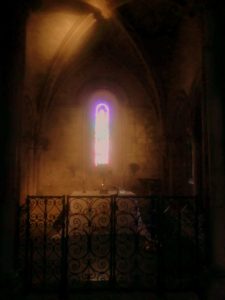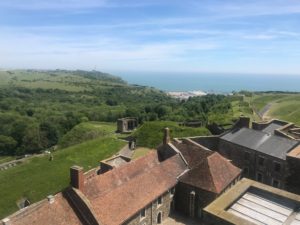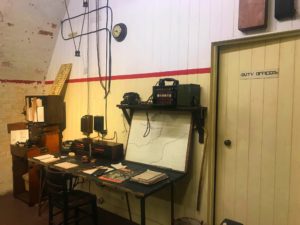Of all the places that have taken me back in time, Dover Castle literally recreated the scenes of the past infront of my eyes. As I walked the palace grounds, suddenly a platoon of redcoat soldiers marched past me. The boys looked handsome in their distinctive regimental coats, white shirts and trousers and cross belts. They gathered in the lawn and enacted a scene out of the daily life of an 18th-century Dragoon soldier, a short morning drill with their commanding officer.
The life of a soldier is believed to have been tough in those times with low wages and limited supplies of food and provisions. The barracks were often cramped up and unhygienic conditions led to frequent widespread diseases. Living in this generation it is tough to imagine the lifestyle of people living centuries back without our modern luxuries and technology. Years later, during the Napoleonic wars, there was major rebuilding exercise done to strengthen the castle’s defenses and a massive labyrinth of underground tunnels were built under the white cliffs of Dover. The tunnels are believed to have housed many secrets of Dover castle and the various military operations it was a part of.
I was brought back to the present as the officer shouted the orders for the day to his soldiers and the troops were dismissed after a quick band beat.
As you visit Dover, you will realize that the secrets of Dover castle are hidden amongst the layers of history that the castle has witnessed. A walk through the premises will not just take you through the different eras but would narrate a tale of pomp, pageantry and intrigue of the royal court. The castle gradually transformed into a giant defensive fortress over the decades with massive brick tunnels being built under it which sheltered troops, underground military headquarters and a hospital. We found it easier to tour the castle by the chronological order of its construction. For me, the most significant times in the history of the castle were during the medieval years and WWII.
Dover’s Early History
One of the most iconic medieval castles in Europe, Dover Castle is the largest castle in England. It was built in the 11th century on the literal edge of the kingdom and has been known as the ‘Key to England’. However, the story of Dover castle starts long before and the remains of the Roman Lighthouse built in the second century proves it. In the first century, Julius Caesar landed at Dover and the Romans built the great lighthouse to guide Roman ships into these lands. Next to the lighthouse is the Anglo – Saxon church of St Mary in Castro which was built in the 10th-11th century. These two structures are believed to be the oldest inside the castle compound and are a good starting point for the castle tour.
Medieval Dover
Henry II, the great-grandson of William the conquerer realized the strategic and emotional importance of Dover castle and built the formidable castle within the fort. The inner and outer baileys and the great keep protected by 14 impressive towers were all built during this era to not just to strengthen the defenses to protect those within but to show royal supremacy and power.
Dover castle has towers, gatehouses and a curtain of a solid stone wall that extends for miles and in the center lies the impressive monumental keep. The interior of the great tower has been refurbished as to how it would have looked during the 12th century with a host of characters recreating the court of King Henry II. So don’t be surprised if you find yourself talking to the queen or the king himself.
The keep also has the royal chapel dedicated to St Thomas Becket, Archbishop of Canterbury, who was murdered because of his conflict with the king. Becket and Henry were best friends and the king by appointing Becket as his chancellor, expected him to reassert royal supremacy over the English Church. However, Becket was against the jurisdiction of secular courts over English clergymen and the disagreement with the king led to a rift between their relationship. On one such incidence, Henry is believed to have uttered the words “Will no one rid me of this turbulent priest?” While what he exactly said is still debated and would probably remain as one of the unfigured secrets of Dover castle, the four knights rode to Canterbury to set the record straight. They killed the praying archbishop in cold blood and in the most ruthless manner possible.
This news shook the people of Europe and the king burdened with guilt began his penitential pilgrimage in reparation for Becket’s murder to Thomas Becket’s tomb at Canterbury Cathedral on foot. The assassins who had fled, at last, traveled to Rome to seek forgiveness and were ordered by the Pope to serve as knights in the Holy Lands. Many say the guilt never left Henry and in some way, the formidable castle was founded on his guilt. In the following years, Henry II spared no effort or expense to add magnificence to Dover castle so as to never let the Becket controversy overshadow his own legacy.
Dover’s Defenses
The medieval castle defenses that are visible today were constructed during three main periods between 1179 and 1256. They evolve over the next 700 years always protecting Dover harbour and the road to London. The medieval tunnels were made to improve the defenses of the castle and conduct surprise attacks on enemies coming by sea. These tunnels were first built after Prince Louis of France besieged the castle in 1216 and have been recently opened to the public. There are no guided tours for these tunnels and you can explore them at leisure.
The panoramic views of the surrounding countryside, harbor and the sea are spectacular from the top of the Great Tower. A walk along the extensive battlements of the castle can also guarantee beautiful sights of the inner gardens and town below.
Garrison Life
Soldiers defended Dover Castle for 900 years. In the medieval period, the garrison consisted of knights and soldiers. Between 1750 and 1958, the castle was refortified and Dover became a Garrison town. During the Napoleonic wars, the extensive tunnel system was dug under the castle to create barracks for soldiers and storerooms for ammunition and supplies. The officer’s new barracks was completed in 1858 and had comfortable rooms for the castle officers. The current restaurant near the underground wartime tunnels called NAAFI used to be the regimental institute used by soldiers to relax and socialize.
Dover at War
The secrets of Dover Castle lie deep in the underground tunnels that run under the castle into the white chalk cliffs of Dover. With five levels of tunnels and many sections still not uncovered, the maze of tunnels can get confusing. Hence, you need to join one of the group tours that are conducted every hour for the tunnels used as HQ of Dover Naval Command and the underground Military Hospital.
Repeater Station HQ DoverThe main tunnel was the center of Operation Dynamo, the evacuation of Dunkirk during WWII. The exhibition displays command rooms and telephone exchanges as they would have been when Vice Admiral Ramsay and his team worked day and night underground to rescue about 3,38,226 people in nine days out of the grasp of German forces.
The success of this operation probably changed the course of the war. A short documentary video footage brings to life the whole rescue mission before the tour ends into a little cute gift shop.
During the cold war, the tunnel below the operation ward, known as Dumpy was commissioned as one of the 12 standby regional government centers of UK in case of a nuclear attack. Thankfully it was never used and remains closed just like the rest of the tunnels some discovered some yet hidden in the past.












































